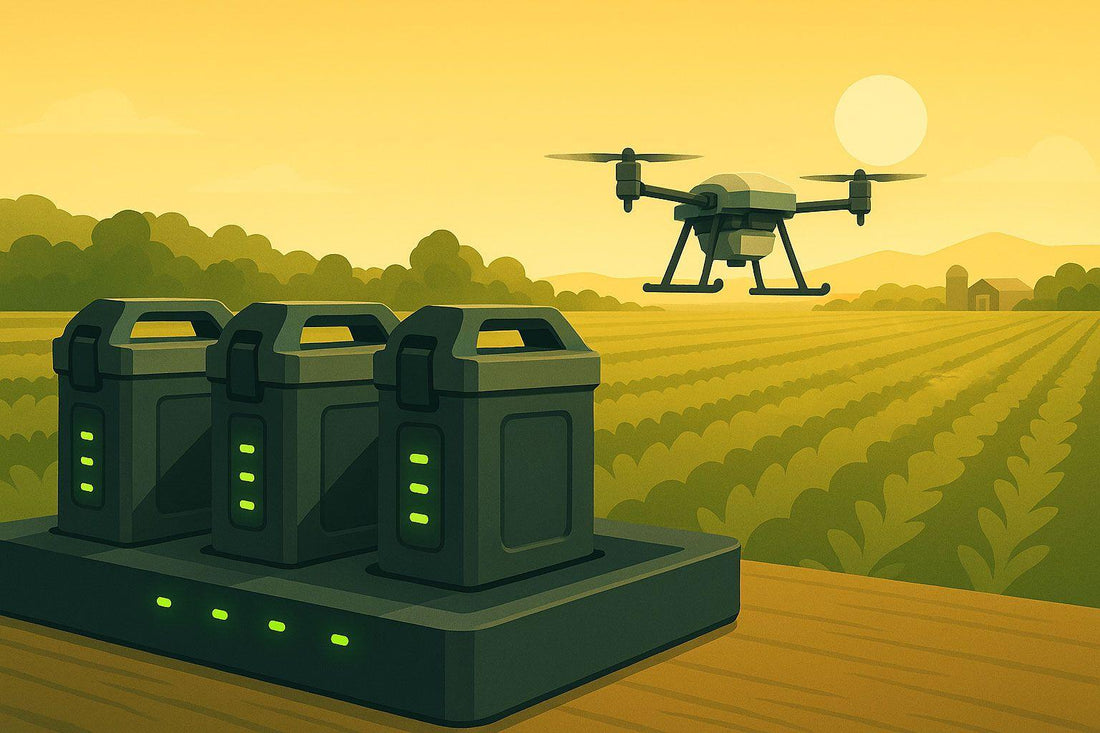
Ultimate Guide to Agricultural Drone Battery Management
Share
Want longer drone flights and lower battery costs? Managing agricultural drone batteries properly can boost your drone's performance, save money, and ensure safe operations. Here's a quick overview of what you need to know:
- Flight Time: Most agricultural drones fly for 8–12 minutes per charge, depending on payload, wind, and temperature.
- Battery Lifespan: LiPo batteries, commonly used, last for up to 1,000 charge cycles if cared for properly.
- Maintenance Tips: Always charge at the right rate (1C–3C), store at 40–50% charge in cool, dry conditions, and inspect for damage before every flight.
- Safety First: Never leave batteries unattended while charging and always use manufacturer-approved chargers.
- Pro Tip: Rotate at least three batteries during operations to keep your drone flying efficiently.
Agricultural Drone Battery Basics
Battery Types and Features
Agricultural spray drones typically use two kinds of batteries: Lithium Polymer (LiPo) and Lithium-ion (Li-ion). Among these, LiPo batteries are the preferred choice because they offer a better power-to-weight ratio, greater flexibility, and higher energy storage capacity.
"We offer a Lithium Polymer (LiPo) battery, so for the T30 battery it's a 29,000 milliampere hour, 51.8 volt battery", explains Kit, an Agri Spray Drone repair technician.
When evaluating battery performance, these specifications are crucial:
| Specification | Role in Performance | Common Range |
|---|---|---|
| Voltage | Determines motor power output | 44.4V - 51.8V |
| Capacity | Affects flight duration | 12,000 - 29,000 mAh |
| Discharge Rate (C-Rating) | Measures power delivery efficiency | 10C - 25C |
| Cycle Life | Indicates long-term durability | 300 - 1,000 cycles |
LiPo batteries maintain steady performance when handled correctly, ensuring reliable operation throughout their lifespan. Knowing these key traits helps you understand how power demands shift during spray operations.
Power Requirements for Spray Operations
A drone's battery performance can change depending on factors like payload weight, wind conditions, temperature, and the layout of the field. High-capacity LiPo batteries are essential for powering agricultural drones effectively. With energy densities ranging from 140 to over 200 Wh/kg, these batteries provide the necessary power without adding excessive weight.
Factors that influence power consumption include:
- Payload weight: Heavier loads require more energy.
- Wind speed: Stronger winds increase power demands.
- Ambient temperature: Extreme temperatures can affect battery efficiency.
- Field geometry: Complex layouts may require more maneuvering and energy.
It's also important to monitor voltage levels, as drops can lower power output and impact spray consistency. The discharge rate (C-rating) plays a key role in ensuring stable power delivery, especially during tasks like carrying a full tank or operating in tough weather. For most agricultural drones, a C-rating between 10C and 25C ensures reliable performance in demanding conditions.
Battery Care and Operation Guidelines
Charging Methods and Steps
Charging your batteries correctly is key to ensuring they last longer, perform well, and stay safe.
| Charging Parameter | Recommended Range/Notes |
|---|---|
| Charging Rate | 1C (standard) to 3C (fast); for new batteries, stick to 1C during the first few cycles. |
| Battery Temperature | Must be at or above 32°F before charging. Never charge batteries stored below 32°F. |
| Cell Voltage | 3.8V–3.85V per cell (ideal for storage). |
| Charging Environment | Use a cool, dry area. Avoid places with flammable materials. |
Always use a charger specifically designed for Lithium Polymer cells, and make sure it includes a balancing feature.
Battery Safety Checks
Before every flight, inspect your batteries thoroughly:
- Look for any damage, swelling, or corrosion.
- Clean the battery contacts using 95% alcohol and a microfiber cloth.
- Ensure batteries are at room temperature before charging.
- Confirm the battery is securely connected in its compartment.
For daily maintenance, clean the battery ports and connection pins with a microfiber towel. Once safety checks are complete, adjust your flight plan to factor in conditions that might affect battery performance.
Flight Duration Planning
Flight times depend on several factors, so planning ahead is essential.
| Factor | Impact on Flight Duration | Management Strategy |
|---|---|---|
| Payload Weight | Heavier loads reduce flight time. | Minimize payload to conserve battery power. |
| Wind Conditions | Strong winds can lower efficiency. | Plan routes with wind patterns in mind. |
| Temperature | Extreme heat or cold impacts batteries. | Pre-warm batteries in cold weather. |
| Field Layout | Complex layouts use more energy. | Adjust spray patterns for field geometry. |
"On average, six to eight minutes is how long it takes to spray out a tank – and the battery will last longer than that", says Kit, an Agri Spray Drone repair technician.
Plan spray missions in 6–8 minute intervals for efficiency. With a 9,000-watt generator, you can recharge batteries in just 8–9 minutes, keeping operations running smoothly.
Storage and Upkeep
Storage Requirements
To get the best performance and lifespan out of your batteries, store them in a cool, dry place with temperatures between 68°F and 77°F. If storing for more than 48 hours, keep the charge level at 40–50%.
| Storage Parameter | Recommended Range | Warning Signs |
|---|---|---|
| Temperature | 68°F - 77°F | Swelling or deformation |
| Charge Level | 40-50% | Failure to recharge properly |
| Maximum Storage Time | Up to 3 months | Shorter flight times, reduced output |
| Humidity | Low to moderate | Corrosion on battery contacts |
Keeping batteries in cool, dry conditions reduces the risk of capacity loss.
Avoid storing batteries fully charged or below 20% charge to prevent long-term damage.
"Your batteries should never be stored on the charging hub unless the hub is unplugged, because of the fire hazard. Store batteries in a hard case after discharging them to about 50%. Before spring operations, fully charge them, use until reaching 20%, then charge again to recalibrate circuits."
These storage practices, paired with regular maintenance, ensure your batteries stay reliable.
Regular Maintenance Steps
Routine maintenance is crucial for keeping your batteries in good shape. Follow this schedule:
Monthly Tasks:
- Check for any physical damage.
- Ensure the storage conditions meet the recommended guidelines.
Quarterly Tasks:
- Complete a full charge–discharge cycle.
- Recalibrate unused batteries by following the correct recalibration process.
For long-term or seasonal storage, like during winter, set the charge to 40–50% and keep the batteries in a hard case. When spring arrives, fully charge the batteries, use them until they hit about 20%, and then recharge fully. This process helps reset the circuits and ensures better performance during use.
sbb-itb-3b7eef7
Mastering Battery Safety & Maintenance for Agras Drones
Equipment and Safety Rules
Using the right tools and following strict safety practices is essential for getting the best performance out of your batteries.
Essential Battery Tools
Here’s a quick overview of the tools you'll need to keep your batteries in top shape:
| Tool Category | Essential Items | Purpose |
|---|---|---|
| Charging Equipment | Balance charger, charging hub | Safely charges batteries while balancing cells |
| Testing Tools | Voltage meter, cell checker | Checks battery health and voltage levels |
| Safety Gear | LiPo-safe bags, fire-resistant case | Protects during storage and transport |
| Maintenance Kit | Contact cleaner, inspection tools | Helps with cleaning and regular inspections |
Safety Guidelines
Follow these key safety rules while charging to minimize risks like overheating or fire:
- Use only manufacturer-approved LiPo chargers with balancing features.
- Keep an eye on the battery's temperature during charging. Stop immediately if it overheats.
- Never leave batteries unattended while charging.
"The most important point above all, knowing how potentially dangerous a LiPo battery can be if something goes wrong, NEVER leave your batteries on charge unattended!" - Zsolt Vaszary, Dronethusiast.com
These steps not only ensure safety but also help extend the life of your batteries.
Signs You Need to Replace Your Battery
Watch for these warning signs that indicate it’s time to replace your battery:
Physical Signs:
- Swelling or visible deformation
- Damaged connectors or wiring
- Cracks or punctures in the casing
If you notice any of these issues, stop using the battery immediately. Before disposal, discharge the battery outdoors and follow your local electronic waste disposal regulations. Proper handling is key to safety.
Battery Management for Drone Efficiency
Managing batteries effectively is key to getting the most out of your drone, especially with flight times typically ranging between 8-12 minutes. Good battery practices can directly impact both productivity and overall drone performance.
Modern LiPo batteries are designed to perform well and last longer when cared for correctly. While they come at a higher cost, proper maintenance ensures they deliver value over time.
Here are some essential tips for maintaining optimal battery performance in the field:
- Use reliable charging equipment: A high-capacity generator, such as one rated at 9,000+ watts, ensures consistent and efficient charging.
- Account for environmental factors: Conditions like temperature and wind can greatly influence battery performance during flights.
- Prioritize maintenance and storage: Regular upkeep and storing batteries in appropriate conditions can significantly extend their lifespan.
- Plan spray missions carefully: Thoughtful flight planning helps conserve battery life and improves operational efficiency.
FAQs
How can I increase the flight time of my agricultural drone?
To maximize your agricultural drone's flight time, try these strategies:
- Use higher-capacity batteries: Opt for batteries with larger capacities to achieve longer flights, but keep in mind that added weight may impact performance.
- Fly in ideal weather conditions: Favor calm, sunny days and avoid flying in rain, strong winds, or extremely cold temperatures, as these can drain the battery faster.
- Minimize unnecessary weight: Remove any non-essential equipment, such as cameras, to reduce the load and improve efficiency.
- Choose efficient flight modes: Select modes that conserve energy, especially when performing tasks like crop spraying.
By combining these approaches, you can significantly extend your drone's flight time while maintaining safe and effective operations.
What are the best ways to store LiPo batteries for maximum safety and lifespan?
To extend the lifespan and ensure the safety of your LiPo batteries, store them in a cool, dry location away from direct sunlight or extreme heat. The ideal storage temperature is between 68°F and 72°F. Avoid placing batteries in areas prone to moisture or high humidity.
For added safety, use a fireproof container, such as a LiPo storage bag or a metal box, to minimize risks in case of a malfunction. When storing for extended periods, keep the battery charge at 40–60% to prevent over-discharge or degradation.
By following these simple steps, you can maintain your batteries' performance and ensure safer operations for your agricultural drone tasks.
How do temperature and wind impact drone battery performance during agricultural tasks?
Environmental conditions like temperature and wind can have a significant effect on the performance and efficiency of drone batteries during agricultural operations. In colder temperatures, batteries may lose capacity, leading to shorter flight times. For instance, extreme cold can reduce battery capacity by up to 25%, which directly impacts the drone's ability to cover large areas efficiently.
Wind also plays a major role in battery performance. Strong winds force the drone to work harder to maintain stability and flight path, which increases energy consumption. Factors like the drone's weight, motor type, and flight speed can further influence how quickly the battery drains. To optimize battery life, it's important to plan flights during calm weather and avoid extreme temperatures whenever possible.
